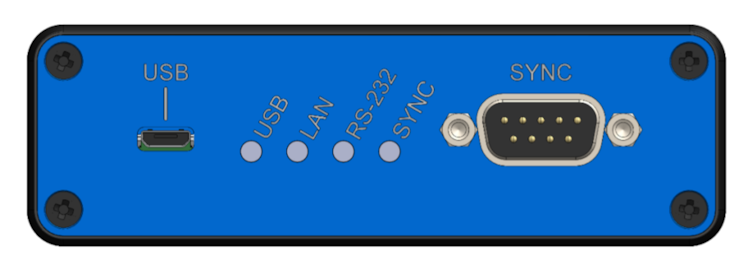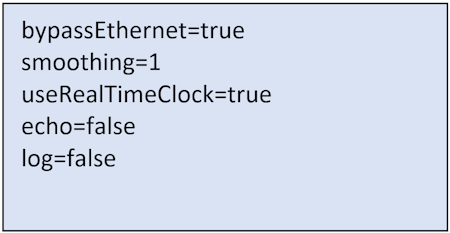Syncbox
The Syncbox is responsible for timing of position data to the SatGen PC. To minimise latency while maintaining stable simulation, it is essential that SatGen receives position data synchronously to the output data that is generated and output to the LabSat. SatGen requires position updates at 100Hz and with minimal jitter. As user simulation software often provides position updates at arbitrary rates, Syncbox is able to receive and re-time incoming user position data and will interpolate output data where necessary.

| Label | Type | Function |
|---|---|---|
| USB | Micro USB | USB data connection to SatGen PC |
| SYNC | 9-way D M | 100 Hz sync pulse from LabSat |
| USB | LED | Indicates activity on USB connector |
| LAN | LED | Indicates activity on LAN input |
| RS-232 | LED | Indicates activity on RS-232 input |
| SYNC | LED | Indicates sync input activity |

| Label | Type | Function |
|---|---|---|
| SD | Micro SD | Micro SD card for configuration |
| RS-232 | 9-way D F | User position input via RS-232 |
| LAN | RJ-45 | User position input via Ethernet |
Data Input to Syncbox
Syncbox can accept data transfer from the user simulation system via Ethernet or RS-232. The data format in each case uses the ASCII NMEA format for $GPGGA.
$GPGGA,HHMMSS.SS,DDMM.MMMMM,K,DDDMM.MMMMM,L,N,QQ,PP.P,AAAA.AA,M,±XX.XX,M, SSS,RRRR*CC<CR><LF>
Ethernet/LAN communication uses UDP protocol. Port number and IP address/DHCP are configurable via the SD card configuration file.
RS-232 data input can be configured via the SD card file.
Configuration of Syncbox via SD card
Configuration of the network interface and serial interface for position input is via a text file which is copied to the micro SD card. The file must be named config.txt. A typical configuration file will look like this when opened in a text editor such as windows notepad:

UDP connection to User System

Serial Connection to User System
Note: The case of the commands does not matter, they can be upper for lower or a mixture of both.
Port
This is the UDP port number over which the Syncbox will receive the NMEA trajectory information.
IP
The IP address of the SyncBox. If this complete line is left out, the DHCP will be used instead.
Smoothing
This value is the amount of smoothing in samples carried out on the input stream. Typically, this value should be 1 if the user NMEA data is supplied at 100 Hz.
The lower this number, the lower the latency of the system. A value of 1 runs at the native latency of SatGen which is ~100 ms. A value of 10 adds 100 ms, and a value of 100 adds 1 second. If the user has 100 Hz + data, a low number would be fine. 10 Hz requires a smoothing rate of at least 20, and 1 Hz requires a smoothing rate of at least 100.
useRealTimeClock
This parameter will use the internal RTC (if a backup-battery is wired in). Leaving this line out it will use the first UTC time received over Ethernet to start the clock.
Echo
Setting this value to ‘true’ will echo over the USB serial the input from the Ethernet port, note this will stop SatGen from working as this uses the USB serial port. Set to ‘false’ for normal use.
Log
If log is set to equal ‘true’, the Syncbox will timestamp and log to microSD card the incoming Ethernet packets, and also log the output from the unit to SatGen. This can be run whilst in normal operations without causing problems with SatGen. However, to avoid filling the microSD card, it is recommended that this parameter is set to ‘false’ unless required.
bypassEthernet
If this statement exists and is ‘=true’ then user data will be taken from the RS-232 input rather than Ethernet UDP.
Sync Cable
The Sync cable connects the LabSat-RT expansion connector to the Syncbox SYNC port. The sync signal is a precisely timed 100 Hz serial code that is used by Syncbox to ensure correctly timing of positional data to the SatGen PC.
| Syncbox End | LabSat End |
|---|
| 9 Way D-Sub Female | < 0.5 m > | 26 Way HD-Sub Male |
|---|---|---|
| Pin 2 | Sync signal from LabSat to Syncbox | Pin 6 |
| Pin 5 | GND | Pin 15 |
